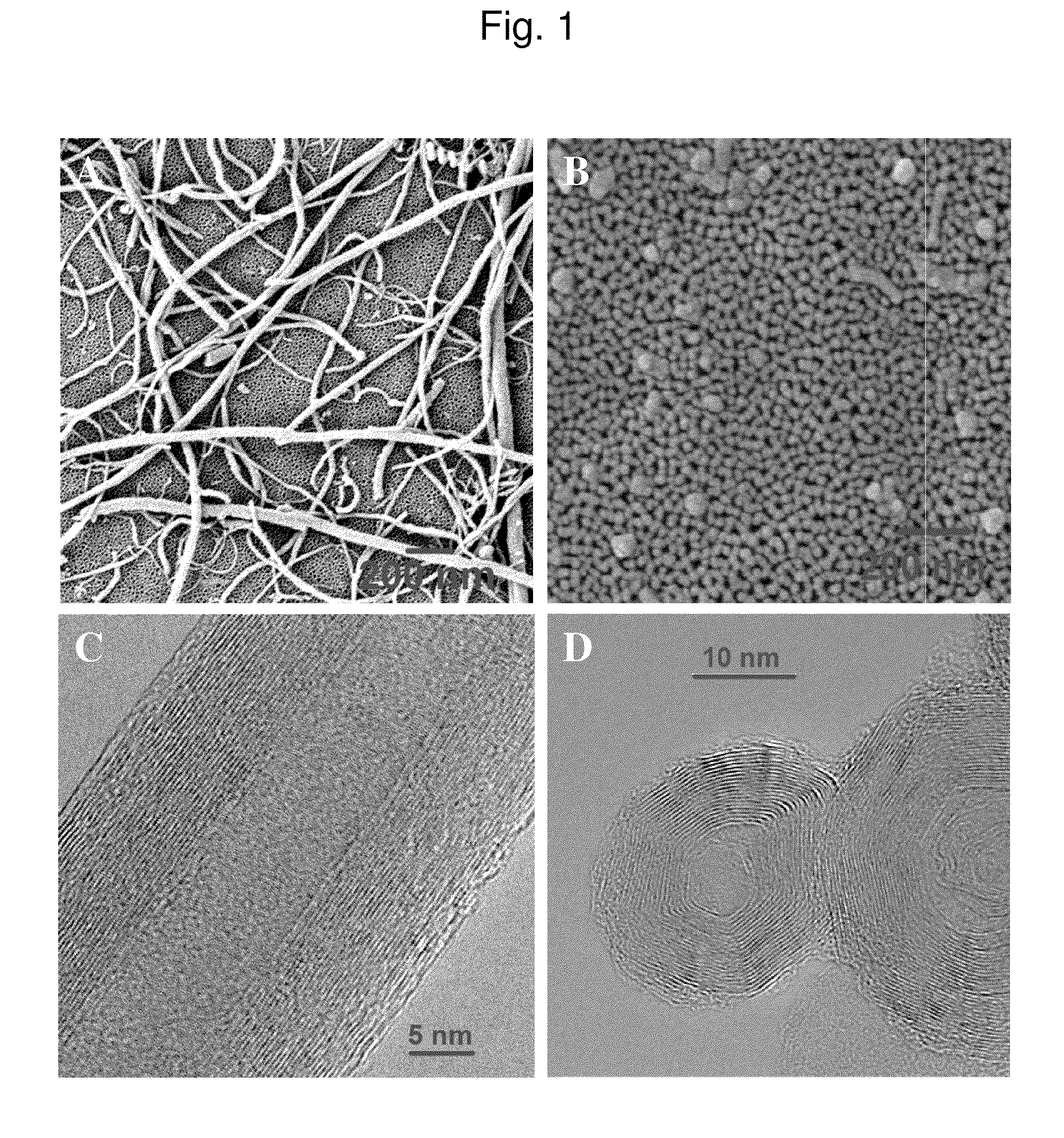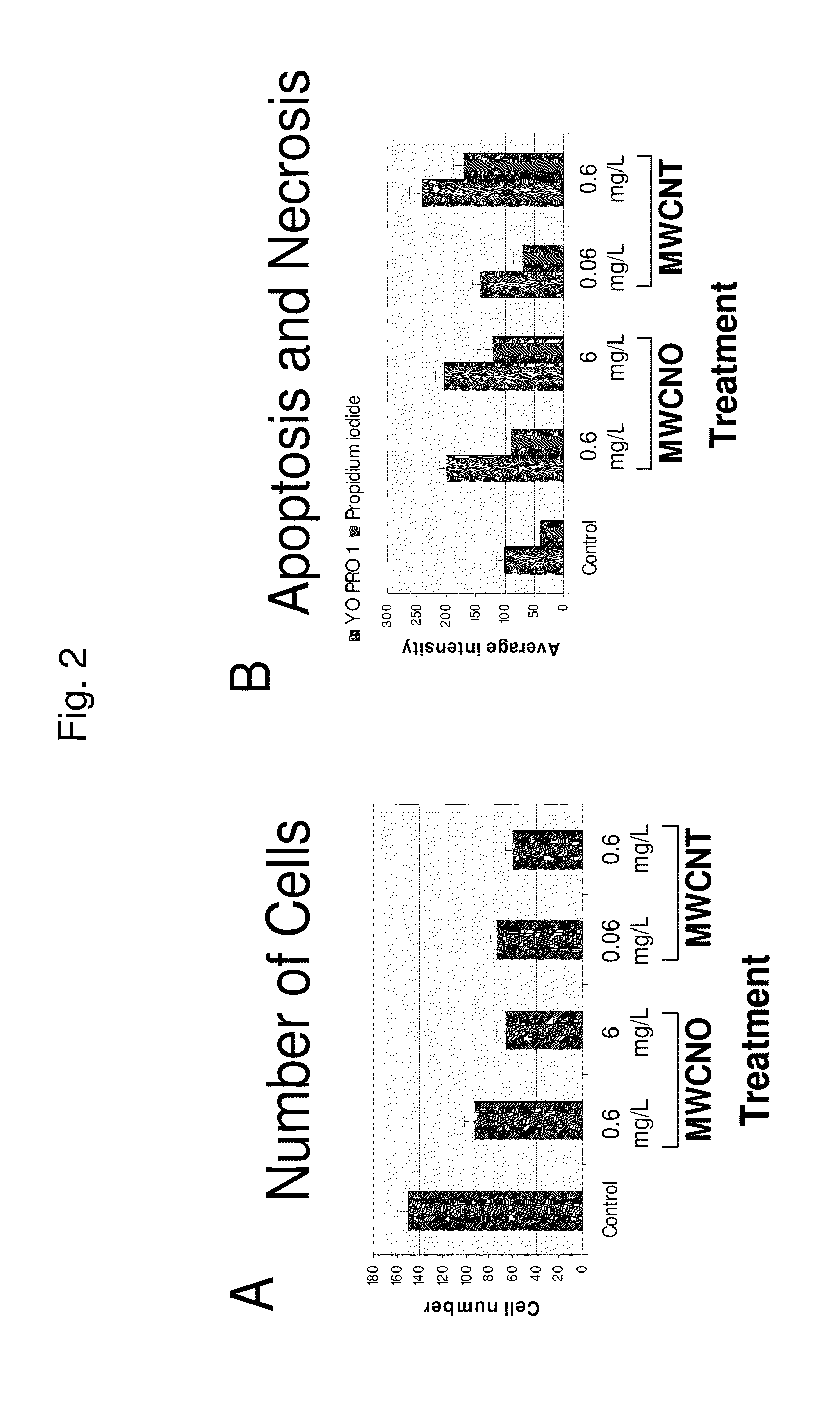Toxicology and Cellular Effect of Manufactured Nanomaterials
a nanomaterial and toxicology technology, applied in the field of carbon nanomaterials, can solve the problems of limited aerosol release of mwcnos and mwcnts during manufacturing, inability to fully understand the molecular mechanisms of cytotoxicity of this class of nanomaterials, and the risk associated with exposure, so as to achieve the effect of reducing toxic effects and eliminating nanotoxicities
- Summary
- Abstract
- Description
- Claims
- Application Information
AI Technical Summary
Benefits of technology
Problems solved by technology
Method used
Image
Examples
example 1
Materials and Methods of Measuring Toxicology of MWCNOs and MWCNTs
[0163]The carbon MWCNOs used in this study were produced by using a modified direct-current electric-arc discharge method based on the methods described by Sano, N., Wang, H., Chhowalla, M., Alexandrou, I. & Amaratunga, G. A. J. Nanotechnology: Synthesis of carbon ‘onions’ in water. Nature (London) 414, 506-507 (2001), hereby incorporated by reference. (See FIG. 1 and infra). The multi-walled carbon nanotubes (MWCNTs) were synthesized by using a chemical vapor deposition (CVD) method as described in Andrews, R., Jacques, D., Qian, D. & Rantell, T. Multiwall carbon nanotubes: synthesis and application. Acc Chem Res 35, 1008-1017 (2002), hereby incorporated by reference. See FIG. 1. Cellomics-based High Content Image Analysis (HCA) has been used for phenotypical measurement of cell apoptosis, necrosis, cell numbers, proliferation, and cell cycle distribution. Apoptotic cells and necrotic cells were detected using DNA dy...
example 2
Evaluating Toxicity in Nanomaterial Exposed Cells
[0182]In this study, the goal was to assess if changes in gene expression in cells exposed to carbon-based nanomaterials shows a correlation to phenotypic observations. Reported here are two approaches to evaluate toxicity in nanomaterial exposed cells; (i) the measurement of phenotypic changes in large populations of cells by high content analysis and (ii) gene expression array analysis in exposed cells. Phenotypically, cells exposed to high concentrations of nanomaterials were observed to undergo apoptosis / necrosis with a concomitant reduction in proliferation indicative of an inflammation response. We found that carbon nanomaterials, generated mRNA level changes in exposed skin fibroblasts, including changes in mRNA levels from genes involved in metabolism, apoptosis, cell cycle, stress response, cellular transport, and inflammatory response. Of interest was our observation that many of the genes that increased in expression in nan...
example 3
Evaluating Apoptosis and Necrosis in Nanomaterial Exposed Cells
[0193]Cytotoxicity was evaluated by staining live cells for 30 minutes with YO-PRO1 (Invitrogen, Molecular Probes), propidium iodide (PI, Sigma) and Hoechst. Live cells are impermeable to YO-PRO1 and PI, both of which are intercalating DNA dyes. Apoptotic cells are permeable to YO-PRO1, whilst PI only stains necrotic cells. Stained culture plates were analyzed using the KSR and images were acquired at each appropriate fluorescence channel for Hoechst, YO-PRO1, and PI. The image analysis software establishes average and total intensity for each nucleus in all channels. In the experiments pictured in FIG. 2, wells were either exposed to the indicated concentration of nanomaterials or the same volume of ethanol solvent as a control, both kept less than 1% of the total volume. Ten replicates were done for each condition with intensities for both YO-PRO1 and PI averaged by well, to obtain the bars in FIGS. 2B and 2C. Student ...
PUM
| Property | Measurement | Unit |
|---|---|---|
| diameter | aaaaa | aaaaa |
| sizes | aaaaa | aaaaa |
| size | aaaaa | aaaaa |
Abstract
Description
Claims
Application Information
 Login to View More
Login to View More - R&D
- Intellectual Property
- Life Sciences
- Materials
- Tech Scout
- Unparalleled Data Quality
- Higher Quality Content
- 60% Fewer Hallucinations
Browse by: Latest US Patents, China's latest patents, Technical Efficacy Thesaurus, Application Domain, Technology Topic, Popular Technical Reports.
© 2025 PatSnap. All rights reserved.Legal|Privacy policy|Modern Slavery Act Transparency Statement|Sitemap|About US| Contact US: help@patsnap.com



